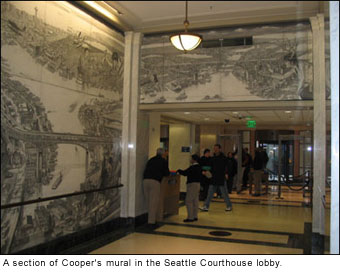Architecture Professor Douglas Cooper's large, panoramic murals tell the stories of cities and their residents all the way from Pittsburgh to Frankfurt, Germany. Often the result of collaborations with these cities' elderly residents, Cooper's murals present a highly personal record of the life and history of each urban area he recreates. Recently, Cooper completed a mural in the King County Courthouse that tells the story of Seattle.

The Seattle mural is composed of smaller murals, a technique that makes viewers feel they can actually walk into the piece. "This particular project is unique because it intricately works with the building's architecture," Cooper said. "Each image works with the individual wall panels while maintaining continuity throughout the room. The mural is basically a series of murals so it is more complex to see the images move through the room."
The courthouse murals illustrate the local history and geography, including attractions such as the Cascade Summit and Pacific Northwest traditions like fishing. The mural also depicts historical figures, including the city's engineer, Reginald H. Thomson. The King County Courthouse is open to the public, allowing visitors to view the mural during normal business hours.

Cooper became involved with the project after he won a King County Arts Council national competition called "4 Culture." His nephew, Gregoire Picher, and former Carnegie Mellon student Patricia Clark (A'03) worked on the mural with Cooper from April 2004 until its installation this past January.
Cooper's other murals can be seen throughout the world. His work appears in Frankfurt am Main, Germany, the University Center at Carnegie Mellon and the main lobby of the Philadelphia Courthouse, to name just a few. In 2000, Cooper received a national award from the American Institute of Architects for the contribution his murals make to architecture.
Related Links:
Carnegie Mellon School of Architecture
Douglas Cooper
University Center Mural



